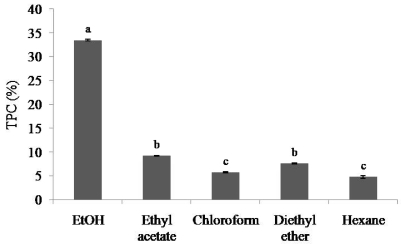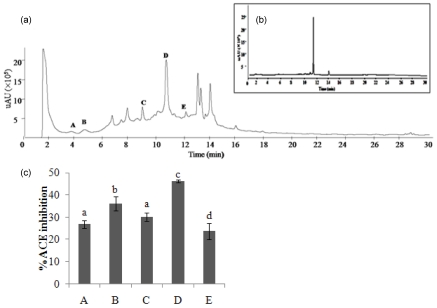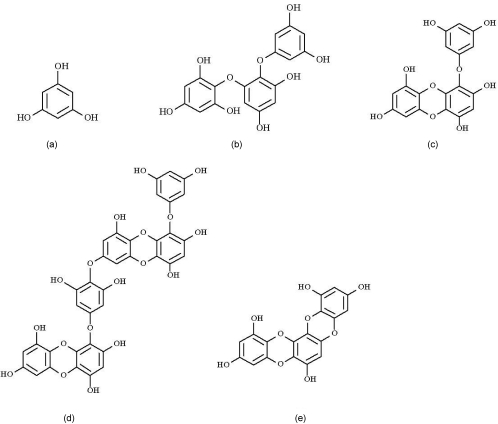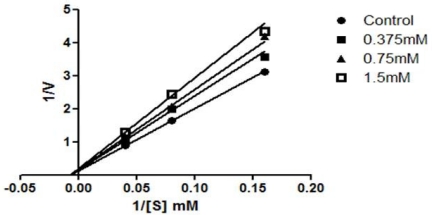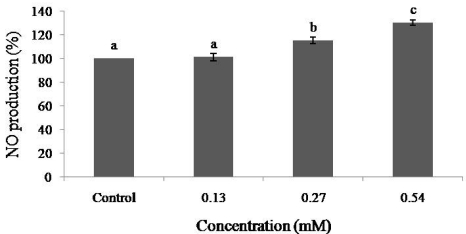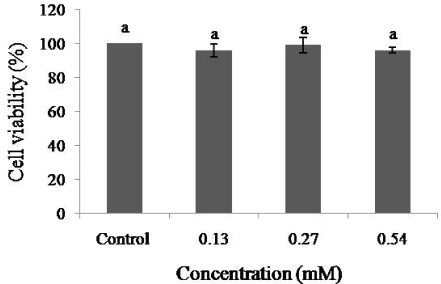Nutr Res Pract.
2011 Apr;5(2):93-100.
Effect of phlorotannins isolated from Ecklonia cava on angiotensin I-converting enzyme (ACE) inhibitory activity
- Affiliations
-
- 1School of Marine Biomedical Sciences, Jeju National University, Jeju 690-756, Korea. youjinj@jejunu.ac.kr
- 2Marine and Environmental Research Institute, Jeju National University, 1 Ara 1-dong, 102 Jejudaehakno, Jeju 695-814, Korea.
Abstract
- Inhibition of angiotensin I-converting enzyme (ACE) activity is the most common mechanism underlying the lowering of blood pressure. In the present study, five organic extracts of a marine brown seaweed Ecklonia cava were prepared by using ethanol, ethyl acetate, chloroform, hexane, and diethyl ether as solvents, which were then tested for their potential ACE inhibitory activities. Ethanol extract showed the strongest ACE inhibitory activity with an IC50 value of 0.96 mg/ml. Five kinds of phlorotannins, phloroglucinol, triphlorethol-A, eckol, dieckol, and eckstolonol, were isolated from ethanol extract of E. cava, which exhibited potential ACE inhibition. Dieckol was the most potent ACE inhibitor and was found to be a non-competitive inhibitor against ACE according to Lineweaver-Burk plots. Dieckol had an inducible effect on the production of NO in EAhy926 cells without having cytotoxic effect. The results of this study indicate that E. cava could be a potential source of phlorotannins with ACE inhibitory activity for utilization in production of functional foods.
MeSH Terms
-
Acetates
Angiotensins
Benzofurans
Blood Pressure
Chloroform
Dioxanes
Dioxins
Ethanol
Ether, Ethyl
Functional Food
Heterocyclic Compounds with 4 or More Rings
Inhibitory Concentration 50
Peptidyl-Dipeptidase A
Phloroglucinol
Seaweed
Solvents
Acetates
Angiotensins
Benzofurans
Chloroform
Dioxanes
Dioxins
Ethanol
Ether, Ethyl
Heterocyclic Compounds with 4 or More Rings
Peptidyl-Dipeptidase A
Phloroglucinol
Solvents
Figure
Reference
-
1. Amenta F, Mignini F, Rabbia F, Tomassoni D, Veglio F. Protective effect of anti-hypertensive treatment on cognitive function in essential hypertension: Analysis of published clinical data. J Neurol Sci. 2002; 203-204:147–151. PMID: 12417374.2. Lee SH, Quian ZJ, Ki SK. A novel angiotensin I converting enzyme inhibitory peptide from tuna frame protein hydrolysate and its antihypertensive effect in spontaneously hypertensive rats. Food Chem. 2010; 118:96–102.
Article3. Jung WK, Mendis E, Je JY, Park PJ, Son BW, Kim HC, Choi YK, Kim SK. Angiotensin I-converting enzyme inhibitory peptide from yellowfin sole (Limanda aspera) frame protein and its antihypertensive effect in spontaneously hypertensive rats. Food Chem. 2006; 94:26–32.4. Bougatef A, Nedjar-Arroume N, Ravallec-Plé R, Leroy Y, Guillochon D, Barkia A, Nasri M. Angiotensin I-converting enzyme (ACE) inhibitory activities of Sardinelle (Sardinella aurita) by-products protein hydrolysates obtained by treatment with microbial and visceral fish serine proteases. Food Chem. 2008; 111:350–356.5. Park EJ, Jhon DY. The antioxidant, angiotensin converting enzyme inhibition activity, and phenolic compounds of bamboo shoot extracts. LWT-Food Sci Technol. 2010; 4:655–659.
Article6. Kim JE, Hwang K, Lee SP. ACE inhibitory and hydrolytic enzyme activities in textured vegetable protein in relation to the solid state fermentation period using Bacillus subtilis HA. Food Sci Biotechnol. 2010; 19:487–495.7. Kim SK, Byun HG, Park PJ, Shahidi F. Angiotensin I converting enzyme inhibitory peptides purified from bovine skin gelatin hydrolysate. J Agric Food Chem. 2001; 49:2992–2997. PMID: 11409999.
Article8. Lee JK, Hong S, Jeon JK, Kim SK, Byun HG. Purification and characterization of angiotensin I converting enzyme inhibitory peptides from the rotifer, Brachionus rotundiformis. Bioresour Technol. 2009; 100:5255–5259. PMID: 19540110.9. Andrews PR, Carson JM, Caselli A, Spark MJ, Woods R. Conformational analysis and active site modeling of angiotensin-converting enzyme inhibitors. J Med Chem. 1985; 28:393–399. PMID: 2983076.
Article10. López-Fandiñoa R, Otte J, van Camp J. Physiological, chemical and technological aspects of milk-protein-derived peptides with antihypertensive and ACE-inhibitory activity. Int Dairy J. 2006; 16:1277–1293.11. Pripp AH, Sørensen R, Stepaniak L, Sørhaug T. Relationship between proteolysis and angiotensin-I-converting enzyme inhibition in different cheeses. LWT-Food Sci Technol. 2006; 39:677–683.
Article12. Miguel M, Alonso MJ, Salaices M, Aleixandre A, López-Fandiñoa R. Antihypertensive, ACE-inhibitory and vasodilator properties of an egg white hydrolysate: Effect of a simulated intestinal digestion. Food Chem. 2007; 104:163–168.
Article13. Wu J, Aluko RE, Muir AD. Production of angiotensin I-converting enzyme inhibitory peptides from defatted canola meal. Bioresour Technol. 2009; 100:5283–5287. PMID: 19570676.
Article14. Quist EE, Phillips RD, Saalia FK. Angiotensin converting enzyme inhibitory activity of proteolytic digests of peanut (Arachis hypogaea L.) flour. LWT-Food Sci Technol. 2009; 42:694–699.15. Marczak ED, Usui H, Fujita H, Yang Y, Yokoo M, Lipkowski AW, Yoshikawa M. New antihypertensive peptides isolated from rapeseed. Peptides. 2003; 24:791–798. PMID: 12948830.
Article16. Karawita R, Park PJ, Siriwardhana N, Jeon BT, Moon SH, Ahn DK, Cho SK, Jeon YJ. Angiotensin I-converting enzyme (ACE) inhibitory activity of elk (Cervus elaphus) velvet Antler. J Food Sci Nutr. 2005; 10:239–243.17. Nakajima K, Yoshie-Stark Y, Ogushi M. Comparison of ACE inhibitory and DPPH radical scavenging activities of fish muscle hydrolysates. Food Chem. 2009; 114:884–851.
Article18. Athukorala Y, Jeon YJ. Screening for angiotensin 1-converting enzyme inhibitory activity of Ecklonia cava. J Food Sci Nutr. 2005; 10:134–139.19. Spence JT. Challenges related to the composition of functional foods. J Food Compost Anal. 2006; 19:S4–S6.
Article20. Cha MH, Lee J, Song MJ. Dieticians' intentions to recommend functional foods: The mediating role consumption frequency of functional foods. Nutr Res Pract. 2010; 4:75–81. PMID: 20198212.21. Li Y, Qian ZJ, Ryu B, Lee SH, Kim MM, Kim SK. Chemical components and its antioxidant properties in vitro: An edible marine brown alga, Ecklonia cava. Bioorg Med Chem. 2009; 17:1963–1973. PMID: 19201199.22. Oyamada K, Tsukidate M, Watanabe K, Takahashi T, Isoo T, Terawaki T. A field test of porous carbonated blocks used as artificial reef in seaweed beds of Ecklonia cava. J Appl Phycol. 2008; 20:863–868.23. Shahidi F. Nutraceuticals and functional foods: whole versus processed foods. Trends Food Sci Technol. 2009; 20:376–387.
Article24. Kim MM, Ta QV, Mendis E, Rajapakse N, Jung WK, Byun HG, Jeon YJ, Kim SK. Phlorotannins in Ecklonia cava extract inhibit matrix metalloproteinase activity. Life Sci. 2006; 9:1436–1443. PMID: 16737716.25. Lee SH, Han JS, Heo SJ, Hwang JY, Jeon YJ. Protective effects of dieckol isolated from Ecklonia cava against high glucose-induced oxidative stress in human umbilical vein endothelial cells. Toxicol In Vitro. 2010; 24:375–381. PMID: 19896528.26. Zhang Q, Zhang J, Shen J, Silva A, Dennis DA, Barrow C. A simple 96-well microplate method for estimation of total polyphenol content in seaweeds. J Appl Phycol. 2006; 18:445–450.
Article27. Koivikko R, Loponen J, Honkanen T, Jormalainen V. Contents of soluble, cell-wall-bound and exuded phlorotannins in the brown alga Fucus vesiculosus, with implications on their ecological functions. J Chem Ecol. 2005; 31:195–212. PMID: 15839490.28. Kang KA, Lee KH, Park JW, Lee NH, Na HK, Surh YJ, You HJ, Chung MH, Hyun JW. Triphlorethol-A induces heme oxygenase-1 via activation of ERK and NF-E2 related factor 2 transcription factor. FEBS Lett. 2007; 581:2000–2008. PMID: 17467702.
Article29. Heo SJ, Ko SC, Cha SH, Kang DH, Park HS, Choi YU, Kim D, Jung WK, Jeon YJ. Effect of phlorotannins isolated from Ecklonia cava on melanogenesis and their protective effect against photo-oxidative stress induced by UV-B radiation. Toxicol In Vitro. 2009; 23:1123–1130. PMID: 19490939.30. Chandler SF, Dodds JH. The effect of phosphate, nitrogen, and sucrose on the production of phenolics and solasidine in callus cultures of Solanum laciniatum. Plant Cell Rep. 1983; 2:105–110.31. Cushman DW, Cheung HS. Spectrophotometric assay and properties of the angiotensin-converting enzyme of rabbit lung. Biochem Pharmacol. 1971; 20:1637–1648.
Article32. Bush K, Henry PR, Slusarchyk DS. Muraceins-Muramyl peptides produced by Nocardia Orientalis as angiotensin-converting enzyme inhibitors. J Antibiot (Tokyo). 1984; 37:330–335. PMID: 6327590.33. Nath J, Powledge A. Modulation of human neutrophil inflammatory responses by nitric oxide: studies in unprimed and LPS-primed cells. J Leukoc Biol. 1997; 62:805–816. PMID: 9400822.
Article34. Mosmann T. Rapid colorimetric assay for cellular growth and survival: Application to proliferation and cytotoxicity assays. J Immunol Methods. 1983; 65:55–63. PMID: 6606682.
Article35. Shibata T, Yamaguchi K, Nagayama K, Kawaguchi S, Nakamura T. Inhibitory activity of brown algal phlorotannins against glycosidases from the viscera of the turban shell Turbo cornutus. Eur J Phycol. 2002; 37:493–500.36. Xu ML, Wang L, Hu JH, Lee SK, Wang MH. Antioxidant activities and related polyphenolic constituents of the methanol extract fractions from Broussonetia papyrifera stem bark and wood. Food Sci Biotechnol. 2010; 19:677–682.37. Handique JG, Baruah JB. Polyphenolic compounds: an overview. React Funct Polym. 2002; 52:163–188.
Article38. Hagerman AE. Extraction of tannin from fresh and preserved leaves. J Chem Ecol. 1988; 14:453–461.
Article39. Porter LJ. Rowe JW, editor. Condensed tannins. Natural products of woody plants I. 1989. Berlin, Germany: Springer-Verlag;p. 651–690.
Article40. Loganayaki N, Siddhuraju P, Manian S. Antioxidant activity of two traditional Indian vegetables: Solanum nigrum L. and Solanum torvum L. Food Sci Biotechnol. 2010; 19:121–127.41. Lee SH, Ko SC, Kang SM, Cha SH, Ahn GN, Um BH, Jeon YJ. Antioxidative effect of Ecklonia cava dried by far infrared radiation drying. Food Sci Biotechnol. 2010; 19:129–135.42. Glombitza KW, Hauperich S. Phlorotannins from the brown alga Cystophora torulosa. Phytochemistry. 1997; 46:735–740.43. Lüder UH, Clayton MN. Induction of phlorotannins in the brown macroalga Ecklonia radiata (Laminariales, Phaeophyta) in response to simulated herbivory--the first microscopic study. Planta. 2004; 218:928–937. PMID: 14716562.44. Heo SJ, Jeon YJ. Radical scavenging capacity and cytoprotective effect of enzymatic digests of Ishige okamurae. J Appl Phycol. 2008; 20:1087–1095.45. You JS, Sung MJ, Chang KJ. Evaluation of 8-week body weight control program including sea tangle (Laminaria japonica) supplementation in Korean female college students. Nutr Res Pract. 2009; 3:307–314. PMID: 20098584.
Article46. Ahn GN, Kim KN, Cha SH, Song CB, Lee J, Heo MS, Yeo IK, Lee NH, Jee YH, Kim JS, Heu MS, Jeon YJ. Antioxidant activities of phlorotannins purified from Ecklonia cava on free radical scavenging using ESR and H2O2-mediated DNA damage. Eur Food Res Technol. 2007; 226:71–79.47. Torruco-Uco J, Chel-Guerrero L, Martínez-Ayala A, Dávila-Ortíz G, Betancur-Ancona D. Angiotensin-I converting enzyme inhibitory and antioxidant activities of protein hydrolysates from Phaseolus lunatus and Phaseolus vulgaris seeds. LWT-Food Sci Technol. 2009; 42:1597–1604.48. Appel HM. Phenolics in ecological interactions-the importance of oxidation. J Chem Ecol. 1993; 19:1521–1552.49. Kang KA, Lee KH, Chae S, Zhang R, Jung MS, Lee Y, Kim SY, Kim HS, Joo HG, Park JW, Ham YM, Lee NH, Hyun JW. Eckol isolated from Ecklonia cava attenuates oxidative stress induced cell damage in lung fibroblast cells. FEBS Lett. 2005; 579:6295–6304. PMID: 16253238.50. Haslam E. Natural polyphenols (Vegetable tannins) as drugs: possible modes of action. J Nat Prod. 1996; 59:205–215. PMID: 8991956.
Article51. Stern JL, Hagerman AE, Steinberg PD, Mason PK. Phlorotannin-protein interactions. J Chem Ecol. 1996; 22:1877–1899.
Article52. Shibata T, Yamaguchi K, Nagayama K, Kawagushi S, Nakamura T. Inhibitory activity of brown algal phlorotannins against glycosidases from the viscera of the turban shell Turbo cornutus. Eur J Phycol. 2002; 37:493–500.53. Tsai JS, Lin TC, Chen JL, Pan BS. The inhibitory effects of freshwater clam (Corbicula fluminea, Muller) muscle protein hydrolysates on angiotensin I converting enzyme. Process Biochem. 2006; 41:2276–2281.54. Hou YC, Janczuk A, Wang PG. Current trends in the development of nitric oxide donors. Curr Pharm Des. 1999; 5:417–441. PMID: 10390607.
- Full Text Links
- Actions
-
Cited
- CITED
-
- Close
- Share
- Similar articles
-
- Enzyme Kinetics and Molecular Docking Investigation of Acetylcholinesterase and Butyrylcholinesterase Inhibitors from the Marine Alga Ecklonia cava
- Effect of Angiotensin Converting Enzyme Inhibitors on Induced Angiotensin Converting Enzyme Activity in Rat Intestine
- Production of Antihypertensive Angiotensin I-Converting Enzyme Inhibitor from Malassezia pachydermatis G-14
- Antihypertensive Angiotensin I-Converting Enzyme Inhibitory Activity and Antioxidant Activity of Vitis hybrid-Vitis coignetiae Red Wine Made with Saccharomyces cerevisiae
- A Study on Angiotensin Converting Enzyne Activity in Pulmonary Tuberculosis

